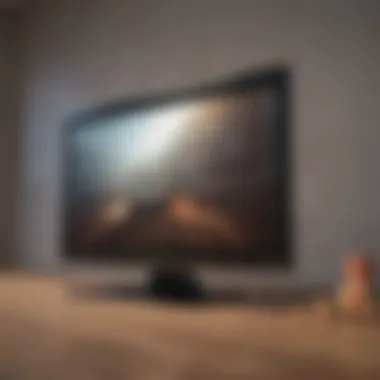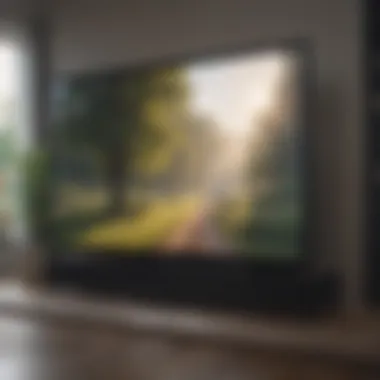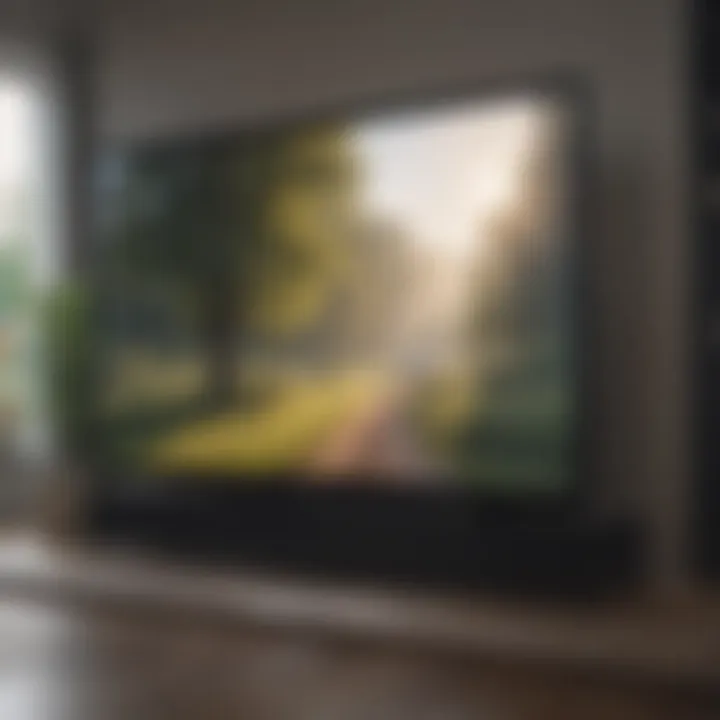A Comprehensive Guide to Cleaning Your TV Screen Safely


Intro
Television screens are an essential part of modern living, providing entertainment and information. However, keeping your TV screen clean can sometimes feel like a challenge. Dust, fingerprints, and smudges can obscure the visual experience, distracting from the content being displayed. Cleaning your TV screen correctly is not only vital for aesthetics but also for the longevity of the device. In this guide, we will delve into the appropriate techniques and materials to ensure your television remains in pristine condition. By understanding the best practices for cleaning, you can maintain both clarity and device integrity.
Understanding Screen Types
Before engaging in the cleaning process, it’s crucial to recognize the type of TV screen you have. Different screens require different care.
- LCD Screens: Liquid Crystal Display screens are delicate. They can scratch easily, so soft materials are necessary for cleaning.
- LED Screens: These are similar to LCD screens but use LED backlighting. They typically require the same cleaning methods as LCDs.
- OLED Screens: Organic Light Emitting Diode screens deliver superior image quality but are also sensitive to cleaning solutions and abrasive materials.
Identifying your screen type helps inform you about appropriate cleaning techniques.
It’s important to always check your manufacturer’s guidelines before proceeding with cleaning.
Cleaning Materials
Choosing the right materials is vital for effective cleaning. Here’s a breakdown of suitable items:
- Microfiber Cloths: These are soft and non-abrasive, ideal for wiping screens without causing scratches.
- Distilled Water: Tap water can leave mineral deposits on screens. Using distilled water can prevent this issue.
- Vinegar Solution: A mixture of equal parts of distilled water and white vinegar can help tackle stubborn stains while being safe for the screen.
- Commercial Screen Cleaners: There are specialized products available, such as those from brands like Whoosh! or Screen Mom, specifically designed for electronics.
- Spray Bottles: Useful for applying cleaning solutions without excess moisture.
Avoid using paper towels, rough fabrics, or cleaners containing ammonia or alcohol, as they can damage the screen.
Cleaning Techniques
Now that you have the right materials, let's explore step-by-step cleaning methods.
Basic Cleaning Steps
- Turn Off the TV: Always begin by switching off the television to prevent damage and allow better visibility of dust and smudges.
- Dust the Screen: Use a dry microfiber cloth to wipe away dust gently. Start from the top and move downward to avoid redistributing dust.
- Prepare the Cleaning Solution: If needed, mix distilled water with vinegar in a spray bottle. Never spray directly on the screen. Instead, spray the solution onto the cloth.
- Wipe the Screen: Using the dampened cloth, gently wipe the screen in circular motions. Avoid applying too much pressure, as this could damage the pixels.
- Dry the Screen: Use a separate dry microfiber cloth to wipe any remaining moisture off the screen.
- Regular Maintenance: Establish a consistent cleaning schedule to maintain clarity. Monthly cleaning is often sufficient for most households.
Screen Preservation Considerations
Taking care of your TV screen extends beyond just cleaning. Here are a few considerations for optimal care:
- Avoid Direct Sunlight: Position your TV away from direct sunlight. This helps prevent screen glare and potential screen burn.
- Keep it Ventilated: Ensure your television has adequate airflow to avoid overheating, which can harm the internal components.
- Use Screen Protectors: Consider applying a safe, removable screen protector for additional protection against scratches.
By adhering to these guidelines, you can foster a maintenance routine that ensures your television remains functional and visually appealing for years to come.
Intro to TV Screen Maintenance
Maintaining the cleanliness of your television screen is crucial for several reasons. First, a clean screen enhances your viewing experience. Dust, fingerprints, and smudges distort visuals and can detract from colors and clarity. Second, regular maintenance can prolong the lifespan of your device. Accumulated dirt can lead to permanent scratches or damages over time.
Additionally, understanding how to clean your TV correctly prevents potential damage to its surface. This guide addresses various screen types, cleaning techniques, and material considerations, ensuring you maintain the integrity of your investment. With an increasing reliance on electronic devices in homes, the significance of keeping screens clean cannot be overstated.
The Importance of Clean Screens
Clean screens are not only about aesthetics; they play a vital role in the functionality of a television. A clean screen provides better image clarity, which can enhance the entire viewing experience. When your screen is clear and free from smudges, blacks appear deeper, colors seem richer, and details become sharper.
Furthermore, consistent cleaning habits can contribute to better overall health. Dust and allergens can accumulate on screens, potentially affecting air quality in the living area. By maintaining a clean screen, you help reduce the possibility of these contaminants affecting your indoor environment. Regular cleaning should become part of your maintenance routine, enhancing not just your entertainment experience but also promoting a healthier living space.


Common Contaminants on TV Screens
Understanding common contaminants helps in addressing the issue effectively. The most frequent sources of dirt on your television include:
- Dust: Fine particles that accumulate over time can obscure viewability.
- Grease and Fingerprints: Touching the screen can leave oily residues that may require more than just a dry cloth to remove.
- Pet Hair and Dander: If you have pets, their fur and dander can settle on screens and result in unsightly smudges.
- Food Particles: Eating in front of the TV can lead to spills and crumbs that find their way to the screen.
Each of these contaminants requires different attention in terms of cleaning methods and materials, which will be elaborated in the following sections.
Understanding TV Screen Types
Understanding the different types of TV screens is crucial when it comes to cleaning them safely and effectively. Each screen type is designed with its own technology, which comes with specific care requirements. Misunderstanding these needs can lead to unintentional damage or reduced display quality. The primary screen types in today's consumer market are LED, OLED, and Plasma screens.
LED and Screens
LED and LCD screens often coexist in discussions. They use liquid crystal display technology, but LED employs light-emitting diodes as a backlight. Both types are vulnerable to scratches and marks if treated incorrectly.
Here are key considerations for cleaning:
- Use a microfibre cloth to prevent scratching.
- Apply gentle pressure while cleaning.
- Prefer a mixture of distilled water and white vinegar as a non-abrasive solution.
Therefore, appropriate cleaning enhances their durability and improves visual performance.
OLED Screens
OLED screens possess a different structure. Each pixel consists of an organic compound that emits its own light. Because of this unique feature, these screens offer superior contrast and vibrant colors. Cleaning them can be sensitive; harsh chemicals can damage the organic material.
- Avoid cleaners containing alcohol or ammonia.
- Use a soft cloth dampened only with water or special screen cleaner formulated for OLED.
This care ensures you are maintaining great picture quality while preventing any screen defects.
Plasma Screens
Plasma screens use gas-filled cells. Though they have become less common, many households still use these models. The screen surface is more delicate and can accumulate dust and fingerprints. Safe cleaning involves:
- Turning off the screen to prevent visual interference while cleaning.
- Damping a cloth lightly to remove dust without putting excessive pressure on the screen.
- Using a cleaner specifically marked safe for plasma screens.
Taking these steps extends the life of your plasma screen and maintains visual clarity.
Pre-Cleaning Considerations
Cleaning your TV screen may seem trivial, but taking the right precautions and gathering the appropriate materials can significantly improve both the cleaning process and the outcome. Before diving into the actual cleaning, understanding the importance of pre-cleaning considerations can help mitigate potential damage to your screen and enhance its longevity.
Safety Precautions
The safety of both yourself and your television should be a priority. Before starting the clean process, there are a few essential safety precautions to consider:
- Unplug the TV: Always disconnect your television from the power source before cleaning. This prevents electrical hazards or accidental damage to settings while handling the device.
- Cool Down the Screen: Allow your TV to cool down for at least 30 minutes before cleaning. Hot screens can be more susceptible to scratches and damage.
- Gentle Handling: When maneuvering the TV, avoid using excessive force. A firm grip is important but be cautious of putting any stress on the screen.
"Taking proper safety precautions can prevent accidents and ensure effective cleaning of your television."
Gathering Necessary Materials


Having the right materials at your disposal ensures that the cleaning process is efficient and effective. Here’s a list of items you may need:
- Microfiber Cloth: This is essential for gently cleaning the screen without scratching it. Microfiber is designed to trap dust and dirt effectively.
- Distilled Water: This is preferable to tap water, as it does not contain minerals that might leave residue on the screen.
- Cleaning Solution: A specialized screen cleaner for electronics can be useful. If unavailable, a mix of equal parts distilled water and white vinegar can be a good alternative.
- Bowl or Spray Bottle: For mixing or spraying your cleaning solution.
In summary, taking these pre-cleaning steps seriously can lead to a cleaner television, decreasing the risk of damage and improving viewing experiences.
By carefully selecting materials and following safety guidelines, you set the foundation for a successful cleaning process.
Safe Cleaning Techniques
The significance of safe cleaning techniques cannot be understated in this guide. Proper techniques not only maintain the optical clarity of your TV screen but also help prolong its life. Using the right methods reduces the risk of scratches, streaks, or damage. Furthermore, applying safe cleaning practices protects the screen from harmful residues which can impair performance over time.
Dusting Off the Screen
Starting with a simple dusting can often be the quickest way to enhance your viewing experience. Dust accumulates over time, creating a film that can distort colors and reduce picture quality. To effectively dust off the screen, first, power off your TV to prevent damage from static electricity. Use a soft, dry cloth or a feather duster to gently wipe the surface. This prevents scratching while removing loose particles. Remember to dust in a circular motion to avoid streaks. Regular dusting should be part of your maintenance routine.
Using a Microfiber Cloth
A microfiber cloth is essential for cleaning television screens safely. This type of cloth attracts dust and hair without scratching the delicate surface. When using a microfiber cloth, it is important to ensure that it is clean and dry. If your screen has smudges, lightly dampen the cloth with distilled water or a suitable screen-cleaning solution. Avoid using any rough materials. Gently wipe the screen using a straight line motion. This technique avoids unnecessary pressure which could lead to damage.
Cleaning Solutions to Use
When it comes to cleaning solutions, selection is critical. Many household cleaners can contain alcohol, ammonia, or other harsh chemicals which are detrimental to TV screens. It is best to use solutions formulated for electronics. Alternatively, a mixture of distilled water and vinegar can work well for most screens. Apply the solution to your microfiber cloth, never directly onto the screen. This helps control the amount of liquid, preventing leaks or pooling that can seep into edges or cracks.
Avoiding Harmful Chemicals
Many commonly used cleaners can be harmful. Avoid solutions that contain ammonia, alcohol, or strong solvents. These can damage the protective coating on your television screen. If unsure about a cleaner’s formulation, opt for products that are explicitly labeled safe for LCD or OLED screens. Always read the ingredient list. By ensuring you're only using safe substances, you help maintain the integrity and longevity of your device.
"Using the wrong cleaning products can significantly compromise the lifespan of your television screen."
In summary, employing safe cleaning techniques is crucial to preserving the quality and clarity of your TV screen. Regular dusting with a microfiber cloth, using appropriate cleaning solutions, and avoiding harmful chemicals all play a part in effective screen maintenance.
Step-by-Step Cleaning Process
Cleaning your TV screen requires a systematic approach. This ensures that every step you take protects the screen, avoids damage, and enhances viewing experience. Following a structured process can also help prevent common mishaps that may arise from a careless cleaning effort. Moreover, understanding each step prepares you for proper maintenance in the future.
Preparing the Screen
Before you begin cleaning your TV screen, you must prepare it correctly. Start by turning off the TV and unplugging it. This not only ensures safety when cleaning but also makes any dirt or smudges easier to see. After the screen is powered down, allow it to cool down. Wiping a heated screen might cause streaks or damage it.
Next, assess the screen for any visible dust or dirt. It can be helpful to use a soft brush or a microfiber cloth to gently remove loose particles. Avoid using anything abrasive that may scratch the screen. Being thorough at this stage can save you time in the next steps.
Applying the Cleaning Solution
Choosing the right solution is crucial. You should only use cleaning solutions specifically designed for electronic screens. Mix a small amount with water if it is concentrated. Apply the solution to a microfiber cloth rather than directly on the screen. This technique prevents excess liquid from seeping into the edges of the screen and potentially causing internal damage.
Important Consideration: Ensure that the cloth is damp, not soaked. Excessive moisture can damage structural components of the TV.
Wiping the Screen
When wiping the screen, use gentle, circular motions. This method helps lift dirt and grime without applying excessive pressure. Focus on one area at a time to ensure thorough cleaning. For stains that are more stubborn, allow the cleaner to sit on the surface for a few moments before wiping.


Be mindful of the edges and corners where dust accumulates. A clean microfiber cloth is essential here; never reuse a dirty cloth as this can cause scratches.
Drying the Screen
After wiping down the screen, the final step is drying. Use a separate, dry microfiber cloth to remove any remaining moisture. Make sure this cloth is soft to avoid leaving any scratches. Gently wipe the screen again using circular motions, ensuring the surface is completely dry. A dry screen not only looks better but also reduces the chances of dust attraction.
Making sure the screen is free of moisture is critical for maintaining picture clarity and prolonging the lifespan of your TV.
Post-Cleaning Tips
Cleaning your TV screen is just the beginning of ensuring its longevity and optimum performance. To maintain the visual clarity that you achieve after cleaning, a well-structured maintenance plan is essential. This section will explore practical tips that can help you sustain a clean screen over time while taking care of the materials involved in the cleaning process.
Regular Maintenance Schedule
Creating a regular maintenance schedule is a fundamental aspect of preserving the quality of your TV screen. Just like any electronic device, the more often you care for it, the longer it lasts and performs well. Here are some points to consider:
- Frequency: Establish a routine for cleaning your TV screen. Many experts recommend a light cleaning every two weeks, with a deeper cleanse once a month.
- Visual Checks: Look for fingerprints, dust, or any other marks regularly. The sooner you clean these blemishes, the easier it is to remove them.
- Companion Tasks: Combine cleaning schedules with other household chores. For instance, clean your screen while you dust the furniture around it. This integrated approach saves time and keeps your living environment consistent.
A proactive cleaning schedule not only keeps your screen clean but also reduces the buildup of dust and grime that can impact display quality.
Storing Cleaning Supplies Properly
The way you store your cleaning supplies can greatly affect their effectiveness. Here are important considerations:
- Organized Storage: Keep your cleaning supplies in a specific location that is easily accessible but also away from direct sunlight. Illumination can degrade some cleaning materials over time and make them less effective.
- Temperature Control: Ensure that your cleaning products are stored in a cool, dry place. Fluctuating temperatures can alter the solutions, making them less safe for use on your TV screen.
- Accessibility: Consider a checklist or a simple container system for your supplies. This system can include microfiber cloths, approved cleaners like those from Zeiss and Screen Mom, and possibly an additional bin for paper towels. Having a straightforward access will make your maintenance efforts easier.
By emphasizing a regular maintenance schedule and proper storage techniques for your cleaning supplies, you enhance your ability to keep your TV screen in pristine condition for longer. These post-cleaning practices are indispensable in your overall TV maintenance strategy.
Common Mistakes to Avoid
Cleaning a TV screen may seem straightforward, but several common mistakes can compromise the integrity of the device or lead to ineffective cleaning. Understanding these pitfalls is crucial for maintaining both the clarity of the screen and its longevity. By avoiding these errors, you can ensure that your cleaning routine contributes positively to your viewing experience.
Using Paper Towels
Many people reach for paper towels when cleaning surfaces due to their convenience. However, this practice is detrimental when it comes to TV screens. Paper towels often contain fibers that can scratch the screen, especially on delicate surfaces like LCD and OLED panels. Additionally, they can leave lint behind, which can diminish visual clarity. Instead of paper towels, opt for a microfiber cloth designed specifically for electronics. These types of cloths are soft enough to prevent scratches and also designed to lift dust and grime without leaving residues.
Cleaning with Excess Pressure
Another prevalent mistake is applying too much pressure while cleaning. Some individuals may think that pressing harder will yield a better clean, but this is not the case. Applying excess pressure can lead to damage, particularly in newer models that have more sensitive screens. Over time, this can cause fading, pixel damage, or even cracking. Gentle motions should be employed when cleaning, allowing the cleaning solution and cloth to do the work without additional force. Remember, a light touch is always safer than a heavy hand.
Ignoring Manufacturer Guidelines
Lastly, neglecting the manufacturer's cleaning recommendations is a serious oversight. Each TV model comes with specific care instructions that reflect the unique properties of its screen. Failing to adhere to these guidelines can result in unwarranted damage or void warranties. For example, some screens may recommend only distilled water with a microfiber cloth, while others may authorize specific commercial cleaning products. Always refer to the user manual for cleaning instructions before proceeding. Following these guidelines helps to maintain the warranty and ensures the longevity of your appliance.
Epilogue
Cleaning your TV screen is not just about aesthetics; it plays a crucial role in maintaining a crystal-clear viewing experience. A clean screen allows for better picture quality and can positively impact how you enjoy your favorite shows and movies. In this article, we emphasized the importance of employing the right techniques and materials. By abiding by these guidelines, you minimize the risk of damage while maximizing the device's longevity.
Understanding the various screen types—LED, LCD, OLED, and Plasma—offers insight into their specific cleaning needs. Each type has different sensitivities and susceptibilities. This knowledge helps inform your approach to cleaning, ensuring that you do not inadvertently cause harm to your device.
Regular maintenance, which includes establishing a cleaning schedule, further enhances your television's durability. You can take simple steps to ensure it remains in good condition.
Recap of Best Practices
When it comes to cleaning your TV screen, here are the key practices to bear in mind:
- Use Appropriate Equipment: Always opt for a microfiber cloth designed for electronics. This minimizes scratches.
- Cleaning Solutions: Water and gentle cleaning agents recommended for TV screens are crucial. Avoid harsh chemicals that can damage coatings.
- Gentle Technique: Remember to use light pressure when wiping. Excess pressure can lead to screen damage.
- Regular Cleaning: Implement a schedule to keep dust and grime build-up to a minimum.
- Manufacturer Recommendations: Follow specific guidelines provided by the manufacturer to ensure compliance and prevent warranty issues.















